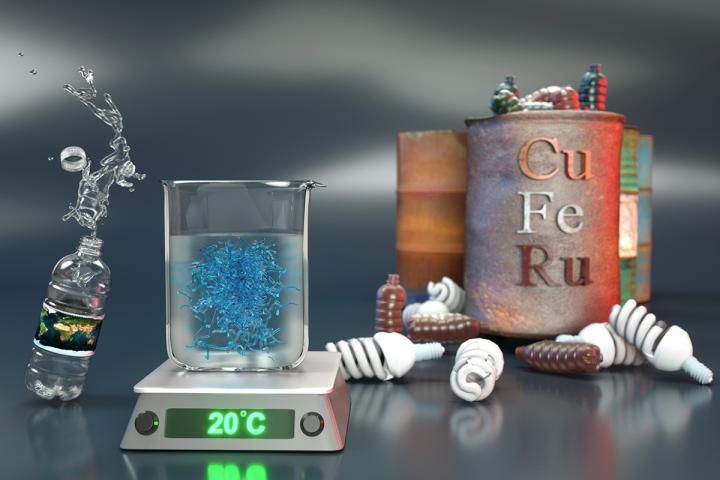

Metal-free atom transfer radical polymerization uses an organic-based photocatalyst.
Credit: Peter Allen, UCSB
A team of chemistry and materials science experts from University of California, Santa Barbara and The Dow Chemical Company has created a novel way to overcome one of the major hurdles preventing the widespread use of controlled radical polymerization.
In a global polymer industry valued in the hundreds of billions of dollars, a technique called Atom Transfer Radical Polymerization is emerging as a key process for creating well-defined polymers for a vast range of materials, from adhesives to electronics. However, current ATRP methods by design use metal catalysts, a major roadblock to applications for which metal contamination is an issue, such as materials used for biomedical purposes.
This new method of radical polymerization doesn't involve heavy metal catalysts like copper. Their innovative, metal-free ATRP process uses an organic-based photocatalyst–and light as the stimulus for the highly controlled chemical reaction.
“The grand challenge in ATRP has been: how can we do this without any metals?” said Craig Hawker, Director of the Dow Materials Institute at UC Santa Barbara. “We looked toward developing an organic catalyst that is highly reducing in the excited state, and we found it in an easily prepared catalyst, phenothiazine.”
“It's “drop-in” technology for industry,” said Javier Read de Alaniz, principal investigator and professor of chemistry and biochemistry at UC Santa Barbara. “People are already used to the same starting materials for ATRP, but now we have the ability to do it without copper.” Copper, even at trace levels, is a problem for microelectronics because it acts as a conductor, and for biological applications because of its toxicity to organisms and cells.
Read de Alaniz, Hawker, and postdoctoral research Brett Fors, now with Cornell University, led the study that was initially inspired by a photoreactive Iridium catalyst. Their study was recently detailed in a paper titled “Metal-Free Atom Transfer Radical Polymerization,” published in the Journal of the American Chemical Society. The research was made possible by support from Dow, a research partner of the UCSB College of Engineering.
ATRP is already used widely across dozens of major industries, but the new metal-free rapid polymerization process “pushes controlled radical polymerization into new areas and new applications,” according to Hawker. “Many processes in use today all start with ATRP. Now this method opens doors for a new class of organic-based photoredox catalysts.”
Controlling radical polymerization processes is critical for the synthesis of functional block polymers. As a catalyst, phenothiazine builds block copolymers in a sequential manner, achieving high chain-end fidelity. This translates into a high degree of versatility in polymer structure, as well as an efficient process.
“Our process doesn't need heat. You can do this at room temperature with simple LED lights,” said Hawker. “We've had success with a range of vinyl monomers, so this polymerization strategy is useful on many levels.”
“The development of living radical processes, such as ATRP, is arguably one of the biggest things to happen in polymer chemistry in the past few decades,” he added. “This new discovery will significantly further the whole field.”












